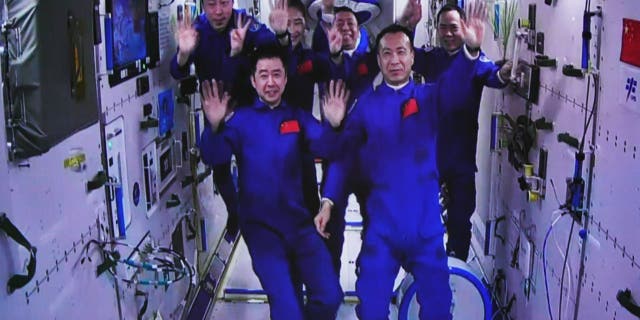China this week revealed that two of its astronauts had conducted a secretive space walk around the Tiangong space station, marking the second extravehicular operation over the last three months.
Two members of the Shenzhou 15 crew, dubbed the “Dream Crew,” successfully exited the space station to complete “scheduled tasks” with the aid of another crew member, who remained in the cabin along with one on ground support, reported its space agency CMSA.
But the announcement came after the operation was successfully completed, which some reporting has suggested has raised concern regarding why China’s space agency chose not to announce the latest out-of-cabin excursion.
This screen image captured at Beijing Aerospace Control Center on Feb. 9, 2023, shows Shenzhou-15 taikonaut Fei Junlong returning to space station lab module Wentian with equipment. The Shenzhou-15 taikonauts on board the orbiting Chinese Tiangong space station completed their first spacewalk at 12:16 a.m. Beijing Time on Friday, according to the China Manned Space Agency. (Photo by Liu Fang/Xinhua via Getty Images)
CHINA RAMPS UP SURVEILLANCE, SECURITY THREAT WITH NEW SATELLITE SUPPORT FROM ANTARCTICA
“For the Chinese Communist Party (CCP), less transparency means more power, the power to deter, disinform and disarm enemies, reflecting ancient Chinese strategic values,” Rick Fisher, a senior fellow with the International Assessment and Strategy Center, told Fox News Digital. “Furthermore, the CCP in all areas, not just outer space, seeks the status of hegemon, meaning that it cannot be accountable to any non-CCP-created rule or value system, so the CCP has no problem not warning other nations about its space activities.”
CMSA provided a vague announcement last month that the crew were planning their first extravehicular operation, led by mission commander Fei Junlong, which was then carried out on Feb. 9.
The three-man crew have been at the space station since Nov. 29, 2022, marking nearly 95 days in orbit.
The “Dream Crew” took over for the Shenzhou 14 crew aboard Tiangong, which also marked China’s first successful handover of a manned crew.

This image captured at the Jiuquan Satellite Launch Center in northwest China shows the Shenzhou-15 and Shenzhou-14 crew waving after a historic gathering in space on Nov. 30, 2022. The three astronauts aboard China’s Shenzhou-15 spaceship entered the country’s space station and met with another astronaut trio on Wednesday, a historic gathering that added the manpower at the in-orbit space lab to six for the first time. (Photo by Guo Zhongzheng/Xinhua via Getty Images)
SCIENTISTS DEBATE WHETHER MOON SHOULD GET ITS OWN TIME ZONE
International space activities have once again worked their way to the forefront of geopolitics, particularly after Russia said last July that it planned to leave the International Space Station amid tense relations with the West, signifying a significant shift in space relations, which in recent decades have steered clear of Earth-based politics.
But even space-based dynamics are changing, and Moscow and Beijing have already looked to shore up their orbital ties.
“CCP contempt for transparency in space is already a global hazard,” Fisher said, adding that this threat will extend towards its lunar ambitions.
Russia and China in November signed an agreement to develop a joint lunar station by 2035, which will involve the construction of a station both in orbit and on the moon’s surface.

This screen image captured at Beijing Aerospace Control Center on Feb. 9, 2023, shows Shenzhou-15 taikonaut Fei Junlong returning to space station lab module Wentian after finishing extravehicular activitiesEVAs. The Shenzhou-15 taikonauts on board the orbiting Chinese Tiangong space station completed their first spacewalk at 12:16 a.m. Beijing Time on Friday, according to the China Manned Space Agency. (Photo by Liu Fang/Xinhua via Getty Images) (Photo by Liu Fang/Xinhua via Getty Images)
CLICK HERE TO GET THE FOX NEWS APP
They have also set into motion two missions that will be carried out before the completion of the space station, one of which will take samples from the moon and deliver them to Earth, while the other will test lunar landing and cargo-delivery capabilities.
The U.S. has also said it will plan another trip to the moon in 2025 for the first time in over half a century, which will also mark the first time mankind has set foot on the moon in over 50 years.